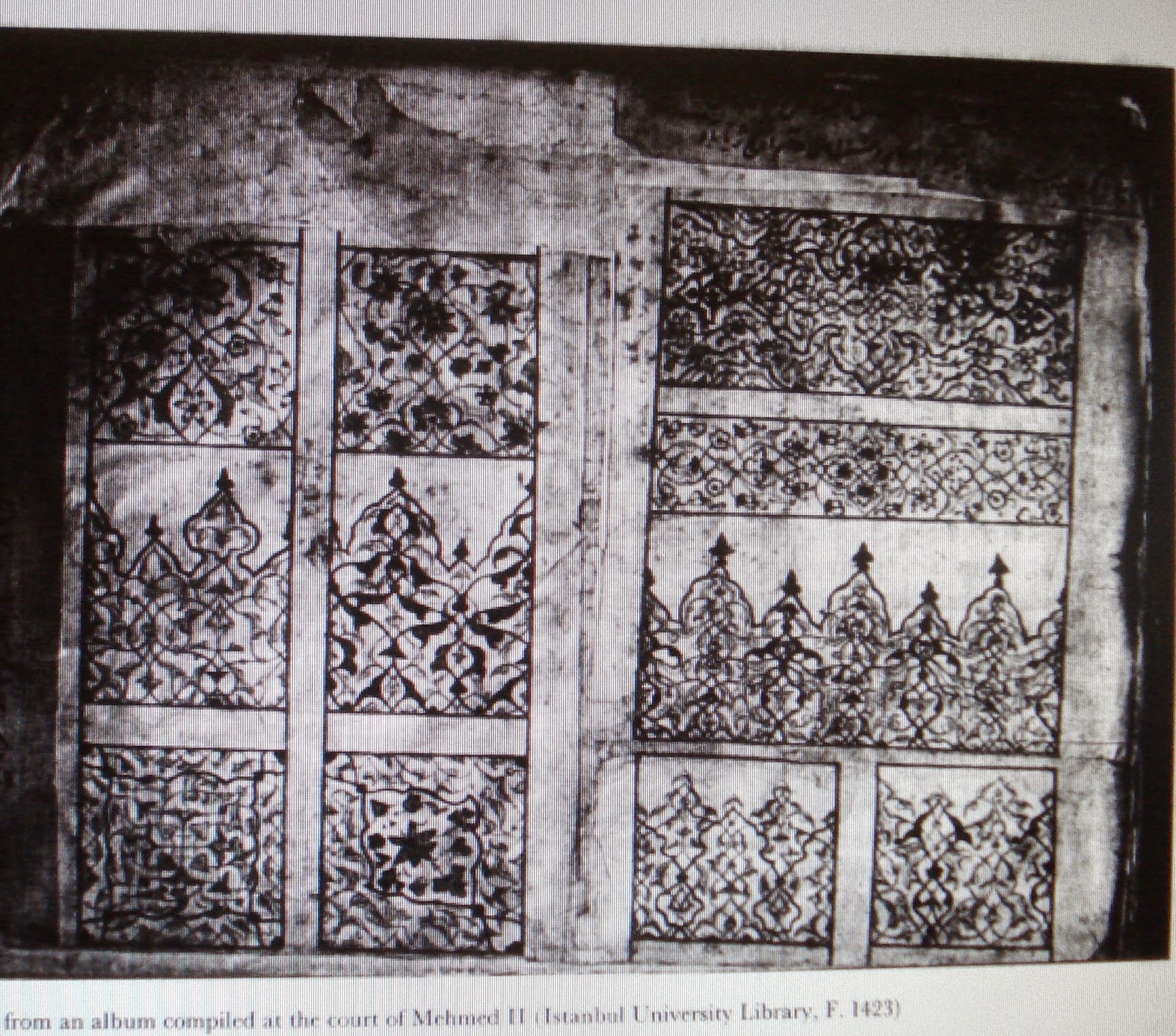There are two different types of design gracing the main border of some Ottoman rugs which are often called with the same term, Gothic border. A misleading one.
The term
Gothic seems to derive from a Transylvanian tradition. No more detailed explanation is given. Actually it appears to have been quite a generic one as it was attributed to two different designs.
 |
| Gothic border 1 |
 |
| Gothic border 2 |
Despite the convenience of the name, it's actually interesting to recognize two distinct designs which source from as two distinct models.
The first is clearly derived from the Kufic ornate style as seen in visual media from the 14th century onwards and widely spread in the vast Timurid empire. This type is still evident in the main border of few early Large Medallion Ushak, as the famous Castellani-Stroganoff . Here the knotted Kufic design embraces a palmette composition.
 |
| Timurid tile, late 14th |
 |
| Ushak Castellani-Stroganoff, border detail 15th-16th |
When the Kufic style was not more on fashion the pattern morphed into the fully floral borders seen in some Ushak rugs (for example the Small medallion Ushak). This pattern was largely used all over the Ottoman empire with many variants depending on the local weaving tradition. The presence of two ornate leaves (called rumi leaf) is a marking point.
 |
| Iznik tile, rumi leaf, 1561 |
 |
| Small Medallion ushak, fully floral border, 16th |
 |
| Central Anatolia, Medallion rug, 16th |
 |
| Ottoman Quran, folio, 1574, The Walters Art Museum |
On the other hand, the second border design shows an affinity with some illuminated borders of books, specifically the Quran. As per related images the motif stands out as part of a medallion gracing the folio's border in given arrangements.
 |
| Ottoman Quran folio, mid 16th, MAS |
 |
| Lotto, 'cartouche' border, 17th. (from Rugtracker) |
At least from the late 16th some western Anatolian weaving centers adopted this half medallion motif in the main border adapting it to their decorative vocabulary, much influenced by the style of the day, the saz style. Its arrangement suggests an allover pattern overlaid by the rug field in the same way as some Lotto 'cartouche' borders do suggest. Despite it appears more or less devoid of its original silhouette and floral features, a crowning palmette is still detectable.
The pattern is found in the white Selendi rugs (Chintamani and Bird type), some white-ground double niche Transylvanian items and the Kiz Ghiordes type.
 |
| Saz style palmette, Iznik tile, mid 16th |
 |
| The Schwarzenberg Chintamani ushak carpet, 16th-17th (photo courtesy Alberto Boralevi)(see bibliography for references) |
A third design can be compared with these two.
This pattern was mostly reserved to the upper panel in prayer rugs, being firstly recorded in the Mamluk Ostler fragment and the Ballard Cairene coupled column exemplar. Very soon replaced by various floral decorations, it later surfaces in some Transylvanian coupled column rugs and in their central Anatolian heirs.
 |
| Ballard Cairene coupled column rug, second half 16th |
 |
| Konya prayer rug, 18th (Alberto Levi Collection) |
Finally, beyond categories, crossbreeds are always to be expected.
'The term Gothic seems to derive from a 'Transylvanian tradition'.
Possibly the Transylvanian population marked via such name a summary affinity of these Turkish designs with the many pinnacles of Gothic buildings as seen in Budapest and Wien.
 |
| St. Stephan Cathedral, Wien. |
 |
| St. Stephan, detail |
------------------
Image credits - Alberto Levi Gallery, "Antique Ottoman Rugs in Transylvania" by S. Ionescu, 2007, Christies, sale 2060, lot 50, "L'Ushak Castellani-Stroganoff" by A. Boralevi, 1987 Firenze, "From International Timurid to Ottoman: A Change of Taste in Sixteenth-Century Ceramic Tiles", by G. Neciplogu.Muqarnas 7 (1991): 136-70, Laure Soustiel, Arts de l'Islam, The Metropolitan Museum of Art.
Bibliographic references -
"Antique Ottoman Rugs in Transylvania" by S. Ionescu, 2007.
"From International Timurid to Ottoman: A Change of Taste in Sixteenth-Century Ceramic Tiles", by G. Neciplogu.Muqarnas 7 (1991): 136-70.
"L'Ushak Castellani-Stroganoff" by A. Boralevi, 1987 Firenze.
"A Carpet Unmasked" in Seven Hundred Years of Oriental Carpets, by K. Erdmann, p. 81



















No comments:
Post a Comment
Note: only a member of this blog may post a comment.